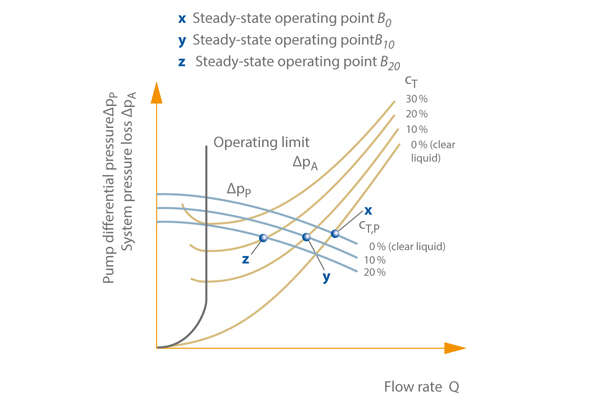Solids transport
Fluids can be used for the transportation of fine- and coarse-grained solids. This process requires the use of piping.
It must be taken into consideration that, in contrast to clear liquids, such mixtures (sludges, pulps, suspensions) tend to separate under the influence of gravity or centrifugal forces. Coarse grain sizes and significant differences in density between the solid and the carrier liquid will encourage separation. Its extent can be gauged by the settling velocity of a solid particle in the still liquid. Turbulence (see Fluid mechanics) in the flow through the pipeline and, due to asymmetrical flow, pressure differences on the solid particles in the vicinity of the pipe wall (see Boundary layer) will tend to counteract this separation process. For this reason the flow velocity as well as the grain size and the solids content in the liquid (i.e. the concentration) will determine the nature of the solids transport.
Solids transport examples
- Sludge transport (homogenous mixture of very small particles of high concentration)
- Suspended particle transport (homogenous mixture of low concentration)
- Jumping particle transport (non-homogenous mixture, with higher concentration at the bottom of horizontal pipes)
- Strand-type particle transport (first sediment layers in the case of horizontal pipes, and concentration at the centre of vertical pipes)
- Slug-type particle transport (transient conditions)
If the permissible concentrations are exceeded, or if the minimum velocities cannot be attained, there is a risk of pipe clogging. These phenomena play a less significant role where the transportation of pulp suspensions (see Pulp pumping) is concerned.
Mixtures of solids and liquids can also be pumped. Considerations regarding wear and economic efficiency determine which pump type is most suitable for this application. Piston pumps are, for instance, employed for handling fine grained materials (grain size up to 3 mm) provided that the periodic pressure fluctuations associated with this type of pump do not rule out its use (see Positive displacement pump).
In the case of coarser grain sizes (see Erosion) the pumps used are exposed to a greater or lesser degree of wear via contact with solids. Employing specialised pump types such as slurry pumps or using appropriate pump materials (see Materials, Plain bearings) can retard the wear process, making application economically viable.
In extreme cases it is necessary to resort to feeding systems designed in such a way that the high-pressure pump handles clear liquids only, while the solids are fed into the pump discharge line (see Pump system) via sluices or tubular chamber feeders.
The pressure loss associated with flowing mixtures of solids and liquids in pipelines is calculated using the same equations as those used for clear liquids. In this case, the pipe friction coefficient (λ) also takes into account the additional frictional losses arising from the solid particles making contact with each other and the pipe walls. The pressure losses can be plotted as a function of the flow rate (Q); this method can also be used to determine any given concentration (cT). See Fig. 1 Solids transport

Fig. 1 Solids transport: Pump differential pressure ∆pp and system pressure losses ∆psys as a function of flow rate Q, for fluids with different solids contents (concentration cT)
The pump's differential pressure Δpp = f(cT) may also rise with increasing concentration of high-density solids.
The minimum value of these resistance curves also determines the minimum flow velocity which must be maintained in order to prevent clogging (see Operating point).
The minimum value of these resistance curves also determines the minimum flow velocity which must be maintained in order to prevent clogging (see Operating point).
